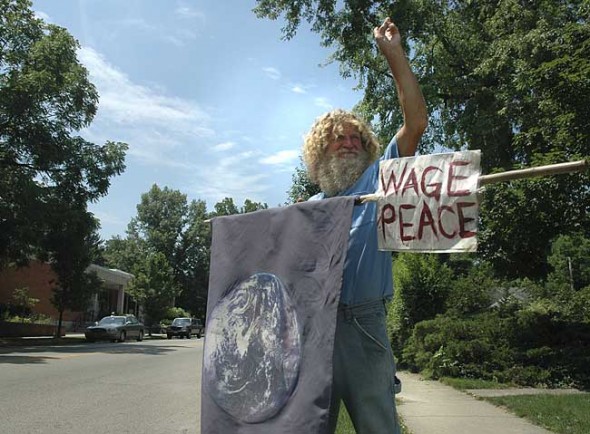
Terry Snider stands at the corner of Xenia Avenue and Limestone Street every Saturday with his Earth flag and peace sign to oppose U.S. military action abroad. He is part of an informal group of protestors that has gathered at that corner from noon to 1 p.m. since late 2002. (photo by Megan Bachman)
Standing up Saturdays for peace since 2002
- Published: July 29, 2010
For an hour every Saturday, a small group of Yellow Springs residents takes to a street corner near downtown with a message of peace. Waving flags and holding signs with such sayings as “War is terrorism” and “Schools not bombs,” the peace activists get honks and hollers from passing motorists, along with the satisfaction that they are standing up for what’s right.
The informal group of protestors, largely retirees, Quakers and war veterans, has gathered at the corner of Xenia Avenue and Limestone Street from noon to 1 p.m. since late 2002, when the run up to the Iraq war began.
“We simply can’t sit on our duff and not do anything about this evil,” said Hazel Tulecke, who initiated the peace protest not long after she was jailed for civil disobedience at an army camp in Georgia. “War doesn’t make sense — not now, not ever.”
Despite the intense sun of a hot July day, Tulecke sat in a lawn chair with a sign that read, “War is not the answer,” while saying that the heat was “nothing like the suffering that other people are going through.”
“It’s the least I can do,” she said.
Flanking Tulecke on a recent Saturday was Terry Snider, a 69-year-old organic farmer, who waved an Earth flag while holding up the peace sign to traffic. Snider said he feels obligated to protest against all military actions, which, he said, “breed more hate, distrust and anger.”
“I’m so opposed to this, if I don’t do something every week I feel guilty,” Snider said. While Snider isn’t doing it for the reaction, he feels that positive responses to the demonstration have been growing.
Across the street, holding a sign boasting, “Bridges not fences,” Janeal Ravndal agreed.
“I don’t know how effective we are, but we always get a friendly response,” said Ravndal, a 72-year-old Quaker. “Being smiled at and waved to by an old lady might be the first step to someone thinking about these things.”
When she moved to Yellow Springs four years ago, Ravndal happened to drive through town on a Saturday at noon. Having served in prison for a week while protesting the Iraq war, she immediately felt welcomed by the nonviolent peace vigil.
“It was a confirmation we were in the right town,” she said.
Alison Murie, 79, finds that the weekly protest cheers her up and induces others to take a stand. Holding a sign that says, “War is the world’s worst investment,” Murie discussed the financial and environmental burden of war.
“It’s not just the cost, it’s the cost to the Earth as the military is the bigger user of fossil fuels,” she said. And while she believes war is inherently evil, she is particularly outraged by discretionary wars to obtain more resources, which, once acquired, will ultimately be expanded by more wars.
Several veterans, who have experienced the horrors of war personally, come to protest, including Alison’s husband Martin Murie, who lost an eye in Italy during World War II, JK Lourens, who lost his arm in an explosion while stationed in Berlin in the 1960s, and Gordon Chapman, who was in army intelligence in World War II.
Despite a consistent level of support from cars and pedestrians, the group receives an occasional hostile response. In addition to the rare middle finger from a passing driver, one of the corners was taken over by a group of George W. Bush supporters during the 2004 presidential campaign.
“They waved American flags — so we took out our American flags,” said peace protestor Rubin Battino, adding that both groups of flag wavers engaged in a peaceful discussion despite their differences.
While the dozen or so protestors who turn out each week have demonstrated on a variety of issues, including environmental concerns and healthcare reform, “peace, not war” is their enduring cry, according to Battino.
“It’s a visual reminder that there are people willing to stand on a street corner on a hot day, or in winter,” Battino said. “If we can do it, you can think about doing it a bit more.”
With their demonstrations many in the group are also pushing for Congress to stem increased military efforts abroad, while others are focusing more on rousing the citizenry, building a movement and using the media.
Murie said that local demonstrations can be the most effective because they are highly visible and draw public and media attention.
“If every little town had a demonstration like this, a lot of people would get to see the message,” she said.
“The role of protest is very important because we want to build a mass movement,” said Martin Murie. “It doesn’t look good right now, but we’ll be here ’til wars are over.”
“This is the last bastion,” said Tulecke.
The 20 core group members encourage others to join them, especially young people, who are underrepresented at the demonstrations.
“It’s not too surprising that older people are out here — we’ve looked at this enough,” Tulecke said.
“When things really change it will be because the youth have gotten involved again,” Ravndal said. “I guess we can hang on until then.”
The Yellow Springs News encourages respectful discussion of this article.
You must login to post a comment.
Don't have a login? Register for a free YSNews.com account.













No comments yet for this article.